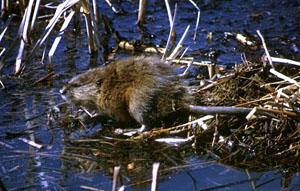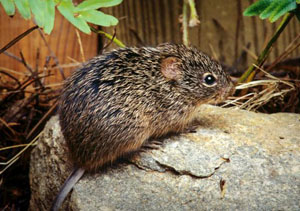Rodents
Based on archeological evidence and historic accounts, small rodents—rats, mice, muskrat, voles, gophers, and squirrels—were among the most commonly eaten animals in the region. These small creatures live in many different habitats and were easy to capture with nets, snares, or traps devised from wood and plant fiber. Historic accounts tell of whole hunting parties on the scout for these tiny prey in south Texas. The Spanish explorer Espinosa encountered groups of “Pacuasian” (likely Pacahuache) peoples who were out hunting mice in the area of present-day Dimmit or Zavala county in the early 1700s.
Among the species identified at sites now covered by the Choke Canyon Reservoir and at the Hinojosa site (41JW8) are cotton rats (Sigmodon hispidus), Southern Plains wood rats (Neotoma micropus), muskrat, (Ondatra zibethicus), pocket gophers (Geomys), ground squirrels (Spermophilus), and pine voles (Microtus pinetorum).
Rodents and other small creatures were featured prominently on the menu for early Paleoindian peoples in South Texas. Late Pleisocene deposits at Berger Bluff above Coleto Creek in Goliad County included bones of pocket mice, woodrats, voles, kangaroo rats, deer mice and grasshopper mice, as well as eastern mole, shrews, rabbit, gopher, raccoon and other small fauna. Many of these, along with a smorgasbord of other small creatures such as frogs, lizards snakes, and birds, were found in a dense deposit, or bone bed, believed to be the remains of a human latrine.
Native peoples at times ate the entire animal, bones, skin, and all, without bothering to cook it. Physical anthropologist D. Gentry Steele, who examined the faunal (bone) assemblage from Choke Canyon site 41LK201, noted that most of the spirally fractured bones of small animals appeared broken while fresh, resembling the bones from human coprolites, and suggesting that “most were broken as the animals were being consumed or while the bones were being passed through digestive tracts.” This finding is in accord with findings from coprolites (preserved human feces) from Hinds Cave in the Lower Pecos area of southwest Texas. These remarkable samples, our best evidence of human meals several thousand years ago, included bits of rodent fur, hair, and a quantity of tiny bones (as well as lizard scales and insect parts). Clearly prehistoric peoples did not always bother with cleaning their tiny prey; rather it was a crunchy but nutritious meal of bones and other odd matter.
Evidence of pine voles in some south Texas archeological sites, such as Hinojosa (41JW8), provides not only dietary information but tells us that the climate was cooler and wetter at the time of the occupation. These creatures, preferring poorly drained, wet grasslands, no longer range this far south into what is now
Muskrats, too, are indicators of a different climate. Whereas today muskrats are found only in areas of the upper Rio Grande and in the northern and eastern edge of the state, their presence at the Hinojosa encampment in Jim Wells county some 400 to 600 years ago indicates that water sources were more permanent at that time. Muskrats thrive in marshy areas, ponds, or slow moving creeks or rivers.

Muskrats, small furry rat-like creatures who make their homes in ponds and rivers, provided both food and fur. |
